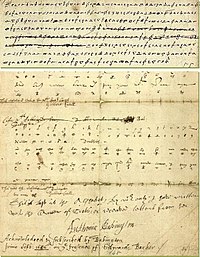Our website is made possible by displaying online advertisements to our visitors.
Please consider supporting us by disabling your ad blocker.
Babington Plot
This article needs additional citations for verification. (October 2013) |

The Babington Plot was a plan in 1586 to assassinate Queen Elizabeth I, a Protestant, and put Mary, Queen of Scots, her Catholic cousin, on the English throne. It led to Mary's execution, a result of a letter sent by Mary (who had been imprisoned for 19 years since 1568 in England at the behest of Elizabeth) in which she consented to the assassination of Elizabeth.[1]
The long-term goal of the plot was the invasion of England by the Spanish forces of King Philip II and the Catholic League in France, leading to the restoration of the old religion. The plot was discovered by Elizabeth's spymaster Sir Francis Walsingham and used to entrap Mary for the purpose of removing her as a claimant to the English throne.
The chief conspirators were Anthony Babington and John Ballard. Babington, a young recusant, was recruited by Ballard, a Jesuit priest who hoped to rescue the Scottish queen. Working for Walsingham were double agents Robert Poley and Gilbert Gifford, as well as Thomas Phelippes, a spy agent and cryptanalyst, and the Puritan spy Maliverey Catilyn. The turbulent Catholic deacon Gifford had been in Walsingham's service since the end of 1585 or the beginning of 1586. Gifford obtained a letter of introduction to Queen Mary from a confidant and spy for her, Thomas Morgan. Walsingham then placed double agent Gifford and spy decipherer Phelippes inside Chartley Castle, where Queen Mary was imprisoned. Gifford organised the Walsingham plan to place Babington's and Queen Mary's encrypted communications into a beer barrel cork which were then intercepted by Phelippes, decoded and sent to Walsingham.[2]
On 7 July 1586, the only Babington letter that was sent to Mary was decoded by Phelippes. Mary responded in code on 17 July 1586 ordering the would-be rescuers to assassinate Queen Elizabeth. The response letter also included deciphered phrases indicating her desire to be rescued: "The affairs being thus prepared" and "I may suddenly be transported out of this place". At the Fotheringay trial in October 1586, Elizabeth's Lord High Treasurer William Cecil – Lord Burghley – and Walsingham used the letter against Mary who refused to admit that she was guilty. However, Mary was betrayed by her secretaries Nau and Curle, who confessed under pressure that the letter was mainly truthful.[3]
- ^ Somerest, Anne (1991). Elizabeth One. pp. 545–548.
- ^ Anthony Babington, Dictionary of National Biography (1895). http://www.tudorplace.com.ar/Bios/AnthonyBabington.htm Archived 21 January 2017 at the Wayback Machine
- ^ Fraser, Antonia (1985). Mary Queen of Scots. pp. 575–577.
Previous Page Next Page


